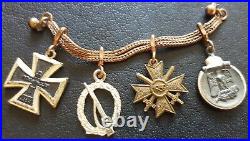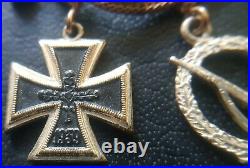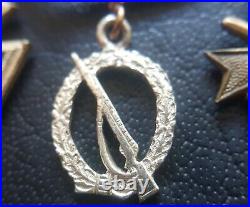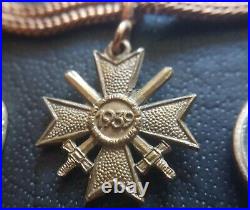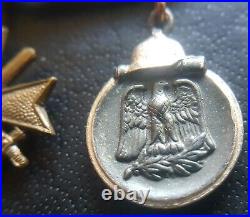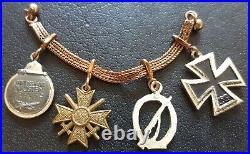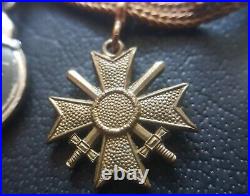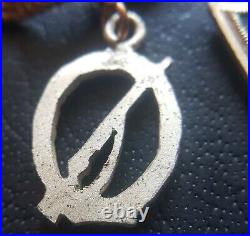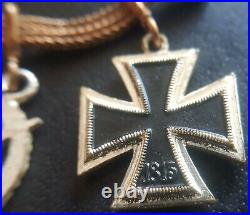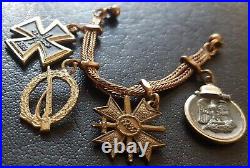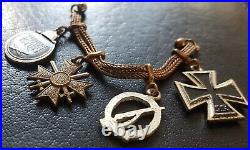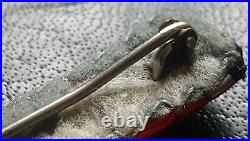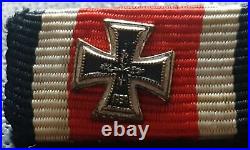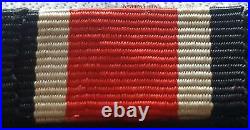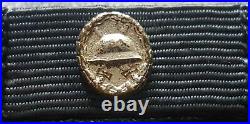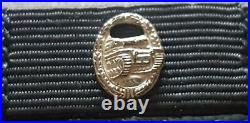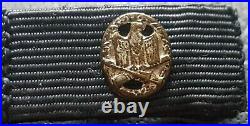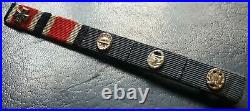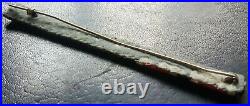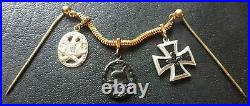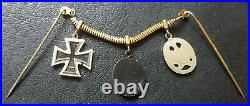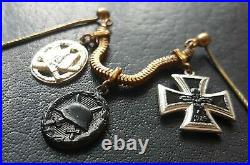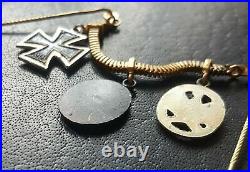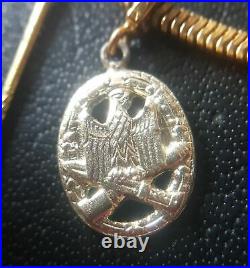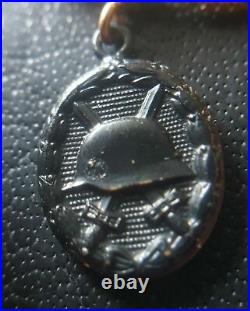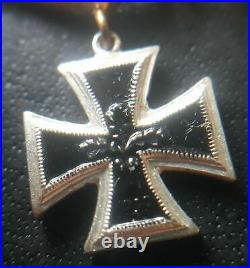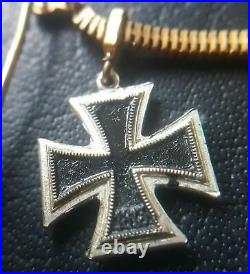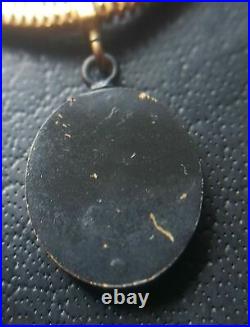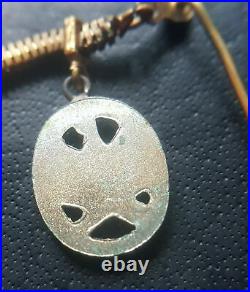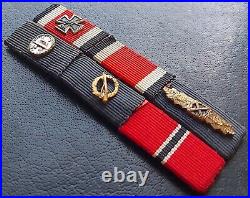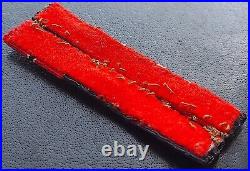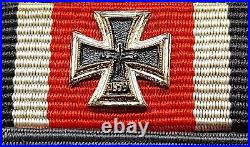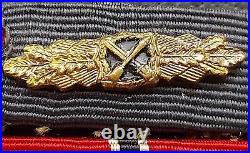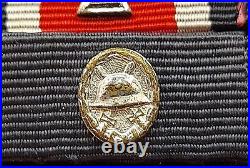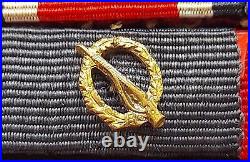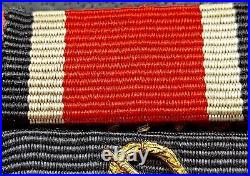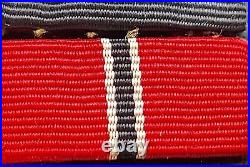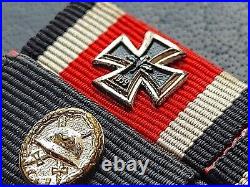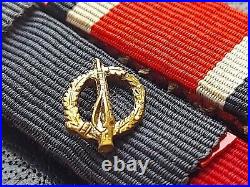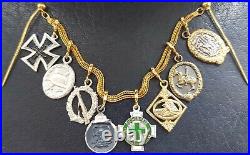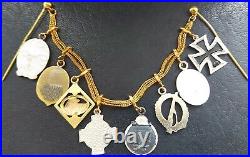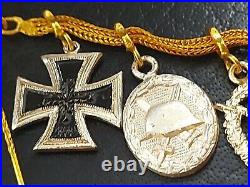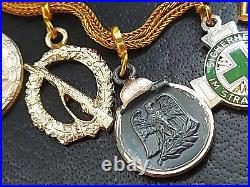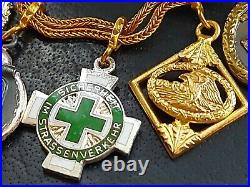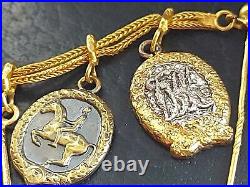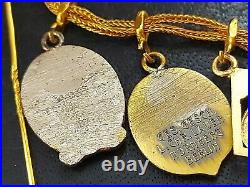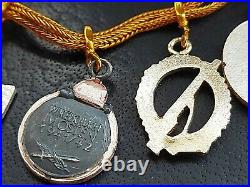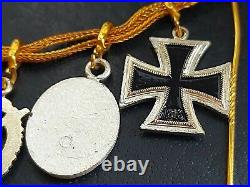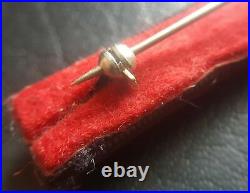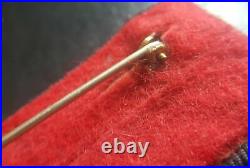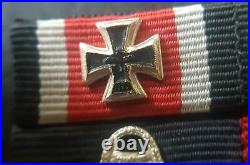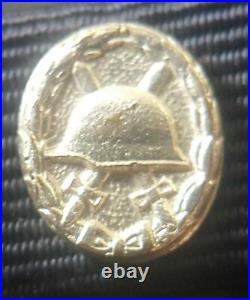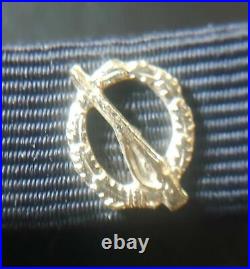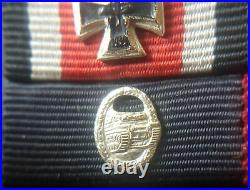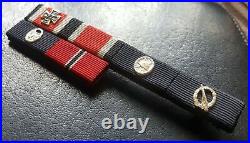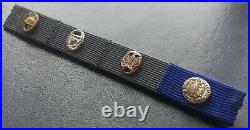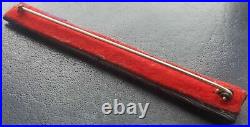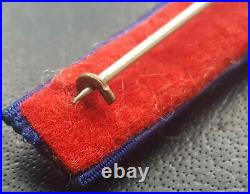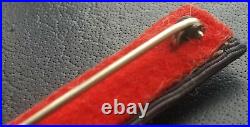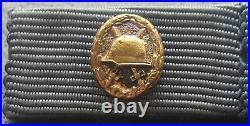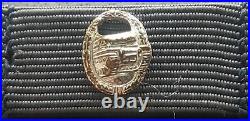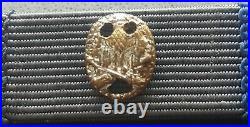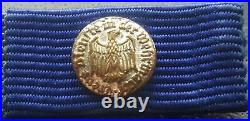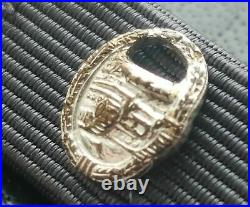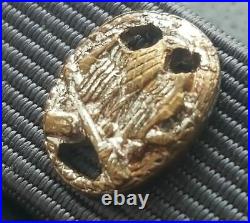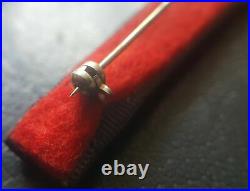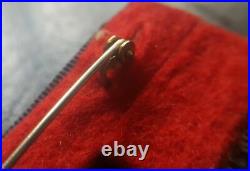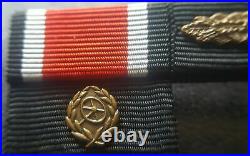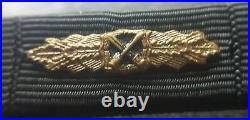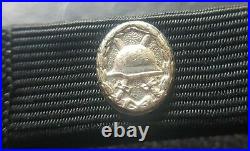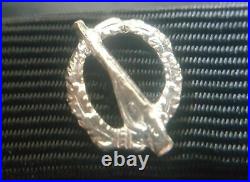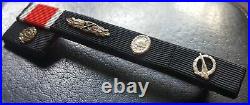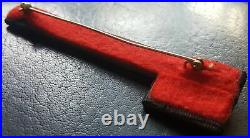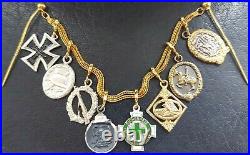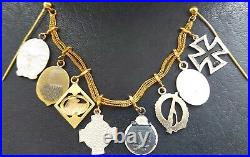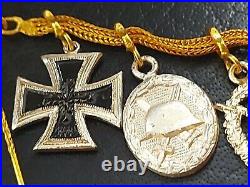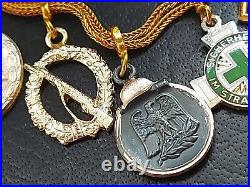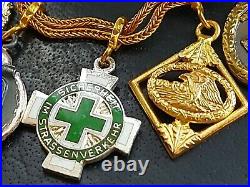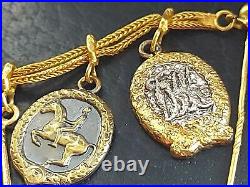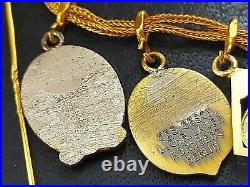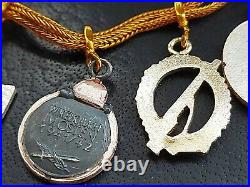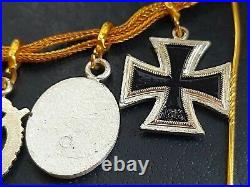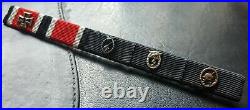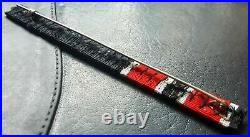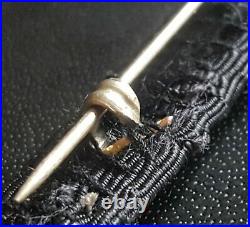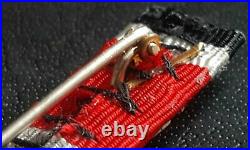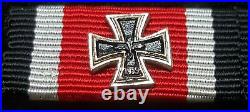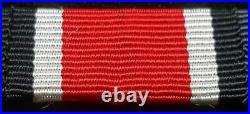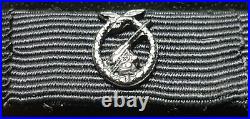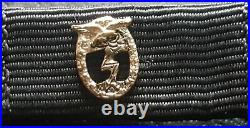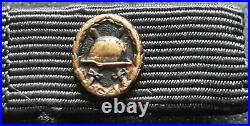Original German post WW2 / 1957 pattern miniatures on chain: Iron Cross II. Class, Wound Badge in Silver, Infantry Assault Badge in Silver, Eastern Front Medal, Honour Cross of the German Traffic Guard in Silver, DLRG / German Lifeguard Association Honour Badge in Gold & DRL German Sports Badge For the War Wounded And Physically Disabled, IN VERY GOOD CONDITION, FINE DETAILED EXAMPLES ON ATTRACTIVE CHAIN, SIZE OF THE MINIATURES: cca 16 mm. FEW FACTS ABOUT 1957 PATTERN AWARDS. In 1957 the West German government authorised replacement Iron Crosses with an Oak Leaf Cluster in place of the swastika, similar to the Iron Crosses of 1813, 1870, and 1914, which could be worn by World War II Iron Cross recipients. The 1957 law also authorised de-Nazified versions of most other World War II-era decorations (except those specifically associated with Nazi Party organizations, such as SS Long Service medals, or with the expansion of the German Reich, such as the medals for the annexation of Austria, the Sudetenland, and the Memel region). The main government contract to manufacture and supply these new de-nazified WW2 1957 official decorations went to the world famous German firm Steinhauer & Lueck, Luedenscheid Germany. Knights Crosses, Iron Crosses, Wound Badges, Tank Assault Badges etc were re-designed by Steinhauer & Lück – often with the oak-leaf spray replacing the swastika, with S&L having the sole patent rights to all WW2 1957 German decorations. S&L did not have the whole monopoly on medal making, other famous firms such as Deschler & Sohn, BH Maher and Juncker also manufactured these new German decorations. Lüdenscheid is situated between the cities Dortmund and Bonn. It was here that one of the youngest medal firms was founded in 1889 by August Steinhauer and Gustav Adolf Lück. The first production began in a cellar, the customer base continued to increase. A property was bought at 51 Hochstrasse which is still home for this famous company today. During WW2 Steinhauer & Lück produced medals and badges, like the famous Knights Cross and many other types of medals and badges. In 1957 this company was awarded the contract to produce all the newly re-designed legal WW2 1957 de-nazified decorations, plus the contract to manufacture all of Germany’s official decorations including Germany’s highest order the Bundesverdienstkreuz. Only a very limited number of original WW2 1957 medals are still produced, mainly Iron Crosses, German Cross Gold & Silver & Wound Badges and are considered 100% genuine by the German Government. HISTORY OF THE AWARDS. Iron Cross (German: Eisernes Kreuz) was a military decoration of the Kingdom of Prussia, and later of Germany, which was established by King Friedrich Wilhelm III of Prussia and first awarded on 10 March 1813 in Breslau. In addition to during the Napoleonic Wars, the Iron Cross was awarded during the Franco-German War, the First World War, and the Second World War. The Iron Cross was normally a military decoration only, though there were instances of it being awarded to civilians for performing military functions. Two examples, the civilian pilot Hanna Reitsch was awarded the Iron Cross First Class for her bravery as a test pilot during the Second World War and Melitta Schenk Gräfin von Stauffenberg (also a German female test pilot) was awarded the Iron Cross Second Class. The Iron Cross was also used as the symbol of the German Army from 1871 to 1915, when it was replaced by a simpler Greek cross. In 1956, the Iron Cross became the symbol of the Bundeswehr, the German armed forces. The traditional design is black and this design is used on armored vehicles and aircraft. A newer design in blue and silver is used as the emblem in other contexts. The Iron Cross is a black four-pointed cross with white trim, with the arms widening towards the ends, similar to a cross pattée. It was designed by the neoclassical architect Karl Friedrich Schinkel and reflects the cross borne by the Teutonic Knights in the 14th century. The ribbon for the 1813, 1870 and 1914 Iron Cross (2nd Class) was black with two thin white bands, the colours of Prussia. The noncombatant version of this award had the same medal, but the black and white colours on the ribbon were reversed. Initially the Iron Cross was worn with the blank side out. This did not change until 1838 when the sprig facing could be presented. Since the Iron Cross was issued over several different periods of German history, it was annotated with the year indicating the era in which it was issued. For example, an Iron Cross from the First World War bears the year “1914″, while the same decoration from the Second World War is annotated “1939″. The reverse of the 1870, 1914 and 1939 series of Iron Crosses have the year “1813″ appearing on the lower arm, symbolizing the year the award was created. The 1813 decoration also has the initials “FW” for King Frederick William III, while the next two have a “W” for the respective kaisers, Wilhelm I and Wilhelm II. It was also possible for a holder of the 1914 Iron Cross to be awarded a second or higher grade of the 1939 Iron Cross. In such cases, a “1939 Clasp” (Spange) would be worn on the original 1914 Iron Cross. A similar award was made in 1914 but was quite rare, since there were few in service who held the 1870 Iron Cross. For the First Class award the Spange appears as an eagle with the date “1939″ that was pinned above the Cross. Although two separate awards, in some cases the holders soldered them together. A cross was the symbol of the Teutonic Knights (a heraldic cross pattée), and the cross design (but not the specific decoration) has been the symbol of Germany’s armed forces (now the Bundeswehr) since 1871. The Iron Cross was founded on 10 March 1813 in Breslau and awarded to soldiers during the Wars of Liberation against Napoleon. It was first awarded to Karl August Ferdinand von Borcke on 21 April 1813. King Wilhelm I of Prussia authorized further awards on 19 July 1870, during the Franco-German War. The Iron Cross was reauthorized by Emperor Wilhelm II on 5 August 1914, at the start of the First World War. During these three periods, the Iron Cross was an award of the Kingdom of Prussia, although given Prussia’s pre-eminent place in the German Empire formed in 1871, it tended to be treated as a generic German decoration. The 1813, 1870, and 1914 Iron Crosses had three grades: Iron Cross 2nd Class German: Eisernes Kreuz 2. Klasse, Iron Cross 1st Class German: Eisernes Kreuz 1. Klasse, Grand Cross of the Iron Cross (German: Großkreuz des Eisernen Kreuzes, often simply Großkreuz). Although the medals of each class were identical, the manner in which each was worn differed. Employing a pin or screw posts on the back of the medal, the Iron Cross First Class was worn on the left side of the recipient’s uniform. The Grand Cross and the Iron Cross Second Class were suspended from different ribbons. The Grand Cross was intended for senior generals of the German Army. An even higher decoration, the Star of the Grand Cross of the Iron Cross, was awarded only twice, to Field Marshal Gebhard von Blücher in 1813 and to Field Marshal Paul von Hindenburg in 1918. A third award was planned for the most successful German general during the Second World War, but was not made after the defeat of Germany in 1945. The Iron Cross 1st Class and the Iron Cross 2nd Class were awarded without regard to rank. One had to already possess the 2nd Class in order to receive the 1st Class (though in some cases both could be awarded simultaneously). The egalitarian nature of this award contrasted with those of most other German states (and indeed many other European monarchies), where military decorations were awarded based on the rank of the recipient. For example, Bavarian officers received various grades of that Kingdom’s Military Merit Order (Militär-Verdienstorden), while enlisted men received various grades of the Military Merit Cross (Militär-Verdienstkreuz). Prussia did have other orders and medals which were awarded on the basis of rank, and even though the Iron Cross was intended to be awarded without regard to rank, officers and NCOs were more likely to receive it than junior enlisted soldiers. In the First World War, approximately four million Iron Crosses of the lower grade (2nd Class) were issued, as well as around 145,000 of the higher grade (1st Class). Exact numbers of awards are not known, since the Prussian archives were destroyed during the Second World War. The multitude of awards reduced the status and reputation of the decoration. The straight-armed Balkenkreuz, the emblem of the Wehrmacht, first used in a narrower form on Luftstreitkräfte aircraft in mid-April 1918, and as shown here, as it appeared on German planes, tanks, and other vehicles during the Second World War. They restored the Iron Cross in 1939 as a German decoration (rather than Prussian as in earlier versions), continuing the tradition of issuing it in various grades. Legally it is based on the enactment Reichsgesetzblatt I S. 1573 of 1 September 1939 Verordnung über die Erneuerung des Eisernen Kreuzes (Regulation for the Re-introduction of the Iron Cross). The Iron Cross of the Second World War was divided into three main series of decorations with an intermediate category, the Knight’s Cross, instituted between the lowest, the Iron Cross, and the highest, the Grand Cross. The Knight’s Cross replaced the Prussian Pour le Mérite or “Blue Max”. They did not care for the Pour le Mérite, as it was a Prussian order that could be awarded only to officers. The ribbon of the medal (2nd class and Knight’s Cross) was different from the earlier Iron Crosses in that the color red was used in addition to the traditional black and white (black and white were the colours of Prussia, while black, white, and red were the colors of Germany). They also created the War Merit Cross as a replacement for the non-combatant version of the Iron Cross. It also appeared on certain Nazi flags in the upper left corner. The edges were curved, like most original iron crosses. The standard 1939 Iron Cross was issued in the following two grades: Iron Cross 2nd Class Eisernes Kreuz 2. Klasse, Iron Cross 1st Class Eisernes Kreuz 1. Klasse abbreviated as EKI or E. The Iron Cross was awarded for bravery in battle as well as other military contributions in a battlefield environment. The Iron Cross 2nd Class came with a ribbon and was worn in one of two different methods: when in formal dress, the entire cross was worn mounted alone or as part of a medal bar, for everyday wear, only the ribbon was worn from the second hole in the tunic button. The Iron Cross First Class was a pin-on medal with no ribbon and was worn centered on a uniform breast pocket, either on dress uniforms or everyday outfit. It was a progressive award, with the second class having to be earned before the first class and so on for the higher degrees. It is estimated that some four and a half million Second Class Iron Crosses were awarded in the Second World War, and 300,000 of the First Class. Heer Infantry Combat Badge, more commonly referred to as the Infantry Assault Badge, was designed by C. Junker of Berlin and instituted on December 20, 1939 by Generaloberst von Brauchitsch. The initial class was instituted in silver and decorated foot infantry who participated in combat action earning a degree of experience that qualified them for the badge. A separate class, in Bronze, was instituted on June 1, 1940. The Bronzed class had criteria similar to the requirements the Silver. There was, however, one notable distinction; The status of the troops, bronzed meant motorized Panzer troops, silver meant foot infantry. The Infantry Assault Badge consists of an oval wreath of oak leaves, made up of four leaves on each side of the arch. Every oak leaf has two acorns, one on each side of the base of the leaf. Centered at the bottom of the badge is a ribbon tied around the wreath, with five raised pellets in a vertical position at the center of this ribbon. The Badges most distinguishable feature is the K98 rifle positioned diagonally across award. The butt of this rifle, positioned on the right, is slightly below the wreath. It leans to the left, with its fixed bayonet protruding through the last of the four oak leaves. The rifle sling forms a loop, hanging from the stock to the butt. Surmounting the wreath is the national emblem; an eagle with down swept wings. The badge has intricate detailing from the eagle down to the bolt on the rifle. The Infantry Assault Badge measures 46mm across and was slightly convex with either a solid or hollow back, and could be die stamped or cast. The reverse had a vertical pin with a hinge that was attached to the back of the eagle, with a retaining “C” clip which retained the clip. The method of attachment for the clip varied, some were welded or soldered while others had a more elaborate scheme where the pin sits in a recessed location the edges of which are crimped in order to hold the hinge in place (pictured above in the Bronzed version). The award was also available in a lapel pin miniature version to be worn whilst in civilian clothing. Wound Badge (German: das Verwundetenabzeichen) was a German military award for wounded or frost-bitten soldiers of Imperial German Army in World War I, the Reichswehr between the wars, and the Wehrmacht, SS and the auxiliary service organizations during the Second World War. After March 1943, due to the increasing number of Allied bombings, it was also awarded to injured civilians. It was ultimately one of the most common of all Third Reich decorations, yet also one of the most highly prized, since it had to be “bought with blood”. The badge had three versions: black (representing Iron), for those wounded once or twice by hostile action (including air raids), or frost-bitten in the line of duty; silver for being wounded three or four times, or suffering loss of a hand, foot or eye from hostile action (also partial loss of hearing), facial disfigurement or brain damage via hostile action; and in gold (which could be awarded posthumously) for five or more times wounded, total blindness, “loss of manhood”, or severe brain damage via hostile action. Badges exist in pressed steel, brass and zinc, as well as some base metal privately commissioned versions. Those of the First World War were also produced in a cutout pattern. All versions of the Wound Badge were worn on the lower left breast of the uniform or tunic. The badge was worn below all other awards on the left. It is thought that more than 5 million were awarded during World War II. In 1957, a revised version of the Wound Badge was authorised for wear. The unaltered Second World War version is shown in the illustration to the right. Wound Badges were primarilly manufactured by the Vienna mint, and by the firm Klein & Quenzer. At first, the Wound badge in Black was stamped from sheet brass, painted semi-matt black, and had a hollow reverse with a needle pin attachment. From 1942, Steel was used to make the badges, which made them prone to rust. The Wound Badge in silver was made (before 1942) from silver-plated brass, and (after 1942) from laquered zinc, and had a solid reverse with either a needle pin or a broad flat pin bar. The Wound Badge in Gold was a gilded version of the Wound Badge in Silver. The Eastern Front Medal (Winterschlacht Im Osten), more commonly known as the Ostmedaille was instituted on May 26, 1942 to mark service on the German Eastern Front (World War II) during the period November 15, 1941 to April 15, 1942. It was commissioned to recognise the hardship endured by German and Axis Powers personnel, combatant or non-combatant, during the especially bitter Russian winter of’41/’42. It was wryly called the “Gefrierfleischorden” (Frozen Meat Medal) by the Heer, Luftwaffe & Waffen-SS personnel to whom it was awarded. Qualification for the award: 14 days served in active combat within the specified area between November 15, 1941 – April 15, 1942, 60 days served in specified area between November 15, 1941 – April 15, 1942, non-combat, wounded in action, killed in action (posthumous award) or injury caused by frostbite (or another injury related to the climate) severe enough to warrant the issue of a Wound Badge. Unique in that its designer was a contemporary serving soldier, SS-Unterscharführer Ernst Krause, the medal was held in high regard by all branches of the Wehrmacht. Measuring 36mm in diameter, of (generally) zinc construction, the medal was given a gun-metal coloured coating. On one side an eagle and the reverse features the text “Winterschlacht Im Osten 1941/42″ featuring a crossed sword and branch below the text. The helmet and outer ring were finished in a polished silver effect. A ribbon that accompanied the medal was coloured red, white and black (symbolic of blood, snow and death). The medal and ribbon were usually presented in a paper packet, but these were invariably discarded. Over 3 million were made by more than 26 confirmed firms by the time the order was officially decommissioned by Oberkommando der Wehrmacht on September 4, 1944. The medal itself was not worn on the combat tunic as per the 1st class Iron Cross & War Merit Cross for example, but worn as a ribbon bar, or as the ribbon alone stitched through the second from top tunic buttonhole as per 2nd Class Iron Cross and War Merit Cross. Honour Cross of the German Traffic Guard (Das Ehrenzeichen der Deutschen Verkehrswacht) – The award is issued in a black, green-lined case. The award was instituted on 7th November 1957. With the approval of the Federal President, the German Traffic Guard donates the German Traffic Guard’s badge of honour in recognition of services dedicated to road safety. The Honour Cross is awarded in two classes. The badge of honour consists of a white enamel wreath with a traffic watch symbol – a green cross in a green ring with the inscription “Sicherheit im Straßenverkehr” (Road Safety). The reverse bears the inscription “Für Förderung der Sicherheit im Straßenverkehr – Deutsche Verkehrswacht” (For the promotion of road safety – German traffic watch). The white enamel cross and the traffic watch symbol are edged with gold in first class and silver in second class. The award is worn in both classes on a green ribbon with white stripes on the left side of the chest. Women wear the badge of honor on a bow of the same color. The badge of honor is awarded by the President of the German Traffic Guard. The Honour Cross were awarded to those persons who, through particularly successful work or through outstanding individual actions, have delivered outstanding services to increasing safety in road traffic, preventing traffic accidents, reducing the consequences of traffic accidents and other tasks and goals of traffic safety work to have. The Deutsche Verkehrswacht (DVW) is one of the oldest and largest citizens’ initiatives in Germany. Founded on November 3, 1924 as “Auto-Wacht” in Berlin, it was banned during the Nazi era and re-established on December 13, 1950 in Bonn. Since the beginning of its existence, it has been committed to traffic education and the education of road users. While in the 1920s the focus was mainly on car traffic, which was just conquering the streets and replacing horse-drawn carriages, today the traffic watch takes the interest of all road users and is committed to the design of safe mobility. Today, around 60,000 volunteers work in 600 local traffic police. They are each summarised in a state traffic watch and through these 16 state associations they are members of the German traffic watch. German Lifeguard Association Deutsche Lebens-Rettungs-Gesellschaft e. DLRG is a relief organization for life saving in Germany. The DLRG is a non-profit, independent organization based on volunteers. On 28 July 1912, a pier in Binz on the island Rügen, Germany collapsed under the load of 1000 people waiting for the cruise steamer Kronprinz Wilhelm. Sailors of the German navy were able to save most people, but 17 people died because they could not swim, including seven children. This catastrophe caused the foundation of the “Deutsche Lebens-Rettungs-Gesellschaft (DLRG)” (German lifesaving organization) on October 19 1913 in Leipzig. With almost 560’000 members in approximately 2,100 local groups, the DLRG is the largest voluntary water rescue organization in the world. Including donators, over one million people support the work of the DLRG. German Riding Badge (Das Reiterabzeichen) – In 1930 the German Warmblood Association created a bronze, silver, and gold rider’s badge, Das Reiterabzeichen, to encourage increased equestrian knowledge and horsemanship. The bronze and sliver levels were awarded after demonstrated horsemanship and knowledge of riding theory, anatomy, and horsemastership. Since the Army was the largest equestrian organization in the country, Rittmeisters (cavalry captains) and artillery captains who were squadron or battery commanders were authorized to administer the tests and award the badges to civilians and to soldiers. According to German cavalry historian Klaus Richter, the army made little use of the badges. This may have been because during the same period the army was in the midst of a dramatic increase in size and modernization program encouraged by the Nazis. It also may have been because military riders, as professionals, did not see a need for a badge to represent what was already represented by their rank and branch of service. It may have been that the testing for and wearing the badges was beneath the dignity of cavalrymen and horse artillerymen. Since it was originally conceived as a civilian sports award before the Nazis came to power. At the copper level, level IV, the modern badge is awarded to beginner riders and is used primarily as a motivational tool to encourage a continued interest in horses. The bronze and higher requirements are more stringent. For example, a bronze level award requires successfully completing the equivalent of a USDFlevel 2 dressage test and jump course with jumps and jump combinations ranging up to 4 feet in height. There is also a written and oral test on horsemastership. The degree of control of all horse activity in Germany has no parallel in the United States. Certainly much of that control, especially in the area of stock management and breeding, goes against the grain of American principles of free markets and individual choice. However, the ability to establish national standards in horsemanship and horsemastership creates industry standards by which one can judge riding instructors, individual ability, and stable and training facilities. It also provides a national standard against which amateur horseman can measure themselves and towards which they can work improve their horsemanship. Pony Club standards are probably the only U. Measure which is similar. DRA/DRL – German National Union for Physical Training Badge – (Deutsches Reichsbund für Leibesübungen). Originally introduced as DRA Badge shortly after the 1913 Olympic games as an incentive to promote physical training among the German population. On its introduction the badge was issued in two grades, bronze and gold and was only awarded to males who met the required criteria. In 1920 a silver grade of the badge was introduced and in 1921 award of the badge was expanded to include eligible females. The bronze badge was awarded to personnel between the ages of 18 and 32 years old who passed the required level of physical training in a twelve month period. In 1933 control of physical training was passed to the Deutsches Reichsbund für Leibesübungen. (German National Union for Physical Training), and the DRA badge was discontinued and replaced by a new DRL badge of the same design with only a change in the central lettering. The badge is a struck bronze award, which is in the form of a 50mm tall, vertical oval oak leaf wreath, encompassing the stylized, cut-out letters, DRL. To the reverse is a vertical pin-back device, hinged to its top and with a catch to its base. The badge was manufactured after the WW2 with the same design existed between 1933 and 1937. This item is in the category “Collectables\Militaria\World War II (1939-1945)\Medals/ Ribbons”. The seller is “a..anderson” and is located in this country: GB. This item can be shipped worldwide.
- Country/Region of Manufacture: Germany
- Country/ Organization: Germany
- Theme: Militaria
- Featured Refinements: Miniature Medal
- Type: Badges
- Conflict: World War II (1939-1945)
- Service: Army
- Era: 1914-1945
